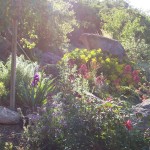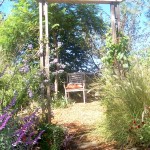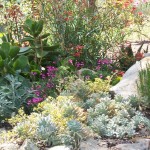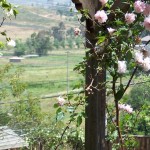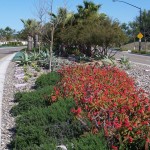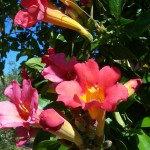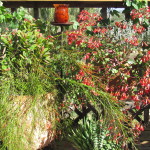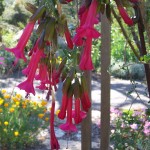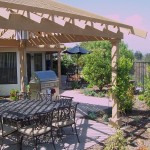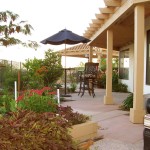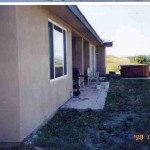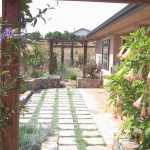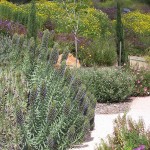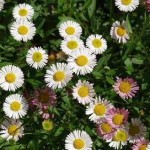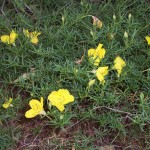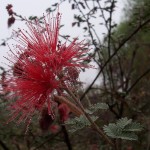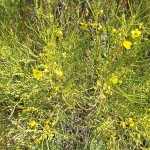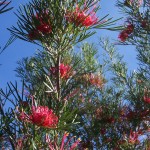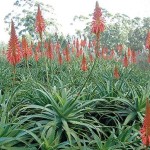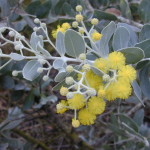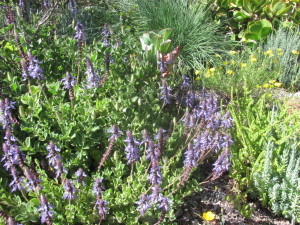 I have a passion for drought tolerant plants, and on one of my last visits to Quail Botanical Gardens in Encinitas (now San Diego Botanic Garden) I was attracted to a plant that looked it would fit the bill: Growing in pure gravel, in the heat of summer, surrounded by other succulents and cacti it was producing cheerful blue-purple flowers. This was one that I had to try out myself, and I have since  fallen in love with it.
I have a passion for drought tolerant plants, and on one of my last visits to Quail Botanical Gardens in Encinitas (now San Diego Botanic Garden) I was attracted to a plant that looked it would fit the bill: Growing in pure gravel, in the heat of summer, surrounded by other succulents and cacti it was producing cheerful blue-purple flowers. This was one that I had to try out myself, and I have since  fallen in love with it.
Some call this South African succulent perennial Lobster Flower, but it also goes under the names of Green Aroma, Dogbane, or Spur Flower; its botanic name is Plectranthus neochilus.  In my hot inland garden  it’s now entering its second summer, and it has proven to be all that I would want from a plant that I select to embellish my or my clients’ water-wise garden. It is hands-down attractive with fuzzy, slightly scalloped pale green aromatic foliage that stays under 6 inches tall in the full sun with little supplemental water but can get taller in the shade with enough water.
Bloom: With enough sun it blooms almost year-round with about 3 to 6 inch tall spikelets along which fragrant blue-purple tubular flowers are arranged that rise above the foliage; in the hot summer sun it is a relief to see that cool intense color. 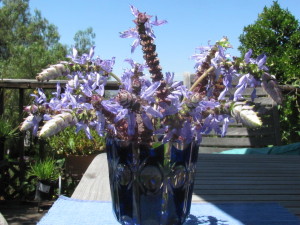
Spread: Mine have spread, starting from a cutting a year ago, to about a foot and a half wide, and they are supposed to continue slowly as the seasons go by. (Propagation from cuttings is extremely easy: Just break off a stem of about 4-5 inches length, remove the lower leaves on 1-2 inches, snip off the flowers, then let dry in a shaded place for a couple of days. Then plant in moist succulent mix, water in and let sit in partial shade for several weeks [don’t forget to keep moist]. I would not plant it out into the garden until the nights are cooler again;  otherwise, the young roots might get burned in the hot soil during the summer months).
Soil:Â The Dogbane or Lobster Flower, like most xeriscape plants, Â needs well draining soil (although I have the feeling that with careful watering it would also do well in heavier soil).
Use: It can be planted at the foreground of a planting bed as colorful ground cover; in the shade it is attractive as well. It drapes nicely over any edging and would make also an attractive plant for hanging baskets or containers.
Hardiness:Â It is hardy to around 30 degrees; mine were hit a bit by frost, but the damaged branches were easily removed.
Deer/rabbit resistance:Â Some sources say that it is deer resistant; rabbits have not touched mine so far.
Water/light needs: It tolerates considerable amount of drought and neglect, and although it prefers full sun or partial shade, it does well in the dry shade also where it makes an attractive ground cover. I would find it an irresistible addition to any desert garden.
With all these attributes, this little perennial is an adorable, rugged and pretty ground cover for the water-conserving, sustainable landscape. What more could you want from a garden friend?
